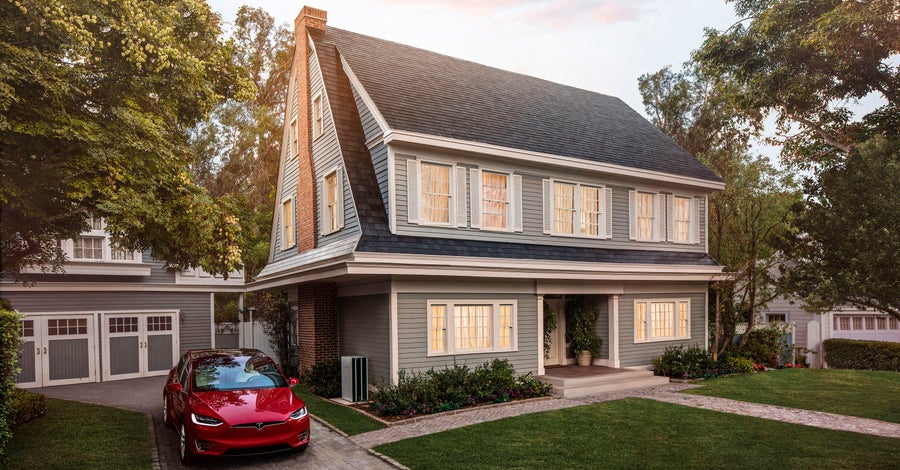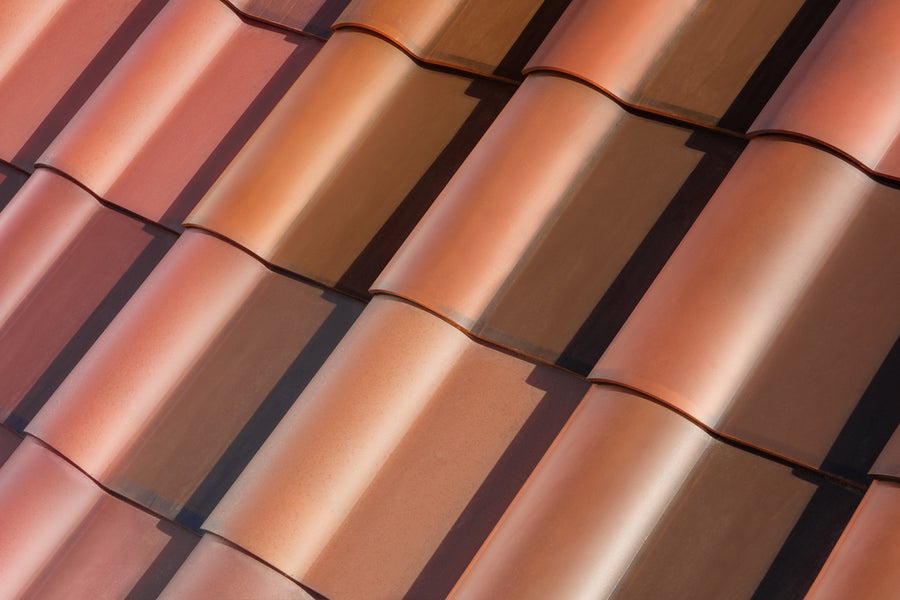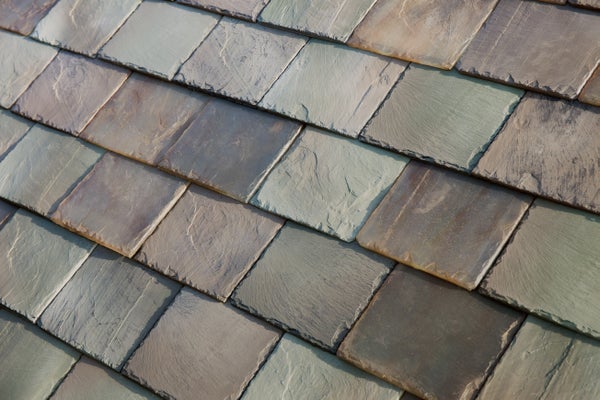Elon Musk has built a formidable personal brand on futuristic visions of driverless cars and space travel. But the Silicon Valley entrepreneur and Tesla CEO could soon make a very real impact in a much-nearer future—and much closer to home—simply by helping U.S. homeowners harness the power of sunlight. This summer Tesla aims to begin installing solar cell roof tiles that look and act like ordinary shingles.
Tesla says the tempered glass tiles let light reach the solar cells embedded within them but can take a hit from a hailstone traveling 100 miles per hour. The design costs more than the solar panel assemblies already perched atop many homes, but the company hopes the tiles’ slicker aesthetics—they come with choices like “textured” or “smooth”—will win over reluctant customers. Technical details are scarce, but experts say the tiles appear to rely on the latest solar cell technology wrapped in a package that attempts to be more aesthetically appealing than standard-issue home arrays.
Home solar energy appeals to both environmental concerns and the desire to “get off the grid,” and metering laws also let U.S. homeowners sell excess solar power back to utility companies. But the allure of going green and saving money is not always enough for those who dislike the sometimes clunky look of traditional rooftop solar panels. “What Tesla has done is to make the shingles blend in with the rooftop," says Barry Cinnamon, founder of Cinnamon Solar, a home solar installation company that is unaffiliated with Tesla. “Everybody would love to have that if the price is not high.”
On supporting science journalism
If you're enjoying this article, consider supporting our award-winning journalism by subscribing. By purchasing a subscription you are helping to ensure the future of impactful stories about the discoveries and ideas shaping our world today.

Tesla's rooftop solar panels are designed to withstand hailstones traveling at 100 mph. Credit: Tesla
Expense certainly does cloud the issue. Companies that previously tried offering rooftop solar tiles have stumbled over steep manufacturing costs and more operational glitches than traditional panels. But Tesla is charging in, officially acquiring SolarCity, a developer and installer of solar power for residential and commercial customers, in November 2016. Tesla also finalized a solar cell–manufacturing partnership with Panasonic in December of the same year. The company's moves may have benefited from timing; the cost of manufacturing solar cells has dropped by 60 percent in the past decade.
Tesla says the preliminary price for its solar roof comes to about $22 per square foot based on the expected mix of solar and ordinary tiles or about $42 if only solar tiles are used. There is a lifetime warranty for the glass tiles and 30 years for the cells embedded in them. That pricing is more likely to attract customers paying for new home construction in the luxury market rather than average homeowners reroofing existing houses, Cinnamon says. Still, he expects to see costs come down if Tesla and other companies can ramp up sales and production in the next five to 10 years. “Tesla has a track record of announcing something and then selling it to the luxury market at the beginning,” Cinnamon says. “Once you have high volume [sales and production], you can sell it at a lower price.
Tesla offers a price calculator that purportedly accounts for how much sunlight reaches a home’s location; the house's square footage and number of floors; the average monthly utility bill; and the percentage of solar tiles in the overall mix. It also includes the federal investment tax credit that currently gives homeowners a one-time credit—usable for directly paying off income tax—equivalent to 30 percent of the total cost of buying and installing solar power.
For example, equipping a sample Colorado home with traditional solar panels generating 5.6 kilowatts would have cost $16,408 without the federal tax credit savings in 2016, says Ran Fu, senior analyst at the National Renewable Energy Laboratory (NREL) in Golden, Colo. He says he calculated that a Tesla solar roof generating the same amount of power for a similar-size home would cost $26,700. That does not figure in an additional $7,000 for a Tesla Powerwall battery (to store extra power)—nor the tax savings. When those kick in, a Colorado homeowner would save a total of $2,600 over 30 years—about a 2.5 percent return on the initial investment. Some homeowners could come out further ahead whereas others could possibly lose money on the investment, depending on their circumstances.

These terracotta solar tiles will be available in 2018. Credit: Tesla
Tesla's calculator does not factor in local and state policies that reward investments in solar power, however. States such as New York and California offer additional tax credits. And some states have more generous net metering laws that determine the payments homeowners get from selling excess power back to the utilities. (Utility companies have pushed back against these payments in some states such as Arizona.)
In 2016 solar power became the number-one source of new electric-generating capacity in the U.S. for the first time, accounting for 39 percent of new capacity. By the end of that year the number of U.S. homes with solar power had reached 1.3 million, despite a slowdown in growth compared with 2015. The overall power generation capacity of home rooftops, however, still pales in comparison with large-scale solar plants built and run by utilities. But U.S. residential solar power has still been rising steadily, with 46 percent growth between 2010 and 2015. “Solar rooftops are one of the big remaining opportunities to integrate large amounts of renewable energy into the United States without increasing the footprint because the houses and buildings are already there,” says Michael Webber, deputy director of the Energy Institute at the University of Texas at Austin.
As the industry gains traction, Tesla's foray could help boost the number of homes with solar rooftops. Experts seem cautiously optimistic that the famously flamboyant company’s residential shingles represent the broader trend of the future. But one uncertainty is whether the federal government and individual states will continue rewarding homeowners for adopting solar power. Another question is how fast overall solar power manufacturing and installation costs will fall.
Tesla will eventually have to “significantly lower costs” of the solar tiles to compete with more traditional panels on price, says David Feldman, senior financial analyst for the NREL’s Washington, D.C. office. But in Tesla's favor, Feldman pointed to the tiles as just one part a larger suite of services that includes home batteries and electric cars. He also noted the company’s efforts to emulate what he called an “Apple Store” model by selling the solar roof to customers shopping for cars in Tesla stores. “They’re expanding the pool of possible solar power customers while potentially having some synergies with the way their sales team operates and the other things they sell,” he says.
